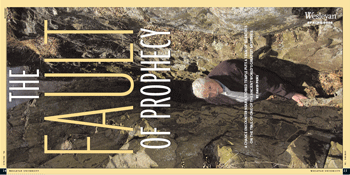The Fault of Prophecy
 THE SOLUTION TO PERHAPS THE GREATEST MYSTERY of ancient Greece depended on a chance meeting near the remains of a Roman villa in Portugal in 1995.
THE SOLUTION TO PERHAPS THE GREATEST MYSTERY of ancient Greece depended on a chance meeting near the remains of a Roman villa in Portugal in 1995.
True, things got clearer as an unsuspecting woman became giddy in a tool shed in Kentucky. Then again, there was the chemical analysis of rock samples and spring water done in Florida. All of these components were key. But truth be told, the solution to the mystery behind the oracle at Delphi—the very oracle referred to in historical accounts from the beginnings of earliest Greek history to Oedipus, but later dismissed as “artful manipulation”—came down to a search for feasible sites for nuclear power plants, and to the well-trained eyes of Jelle Zeilinga de Boer.
Nuclear power plants were very much on the docket of the Greek government in the late 1970s. Anxious to follow the lead of France and other European nations, Greece wanted to afford its citizens access to cheaper electric power. But the government knew there was a problem—the propensity of the fault-ridden landscape to shake with earthquakes. Not wanting to build a disaster, the government retained the services of de Boer, the Harold T. Stearns Professor of Earth Science at Wesleyan, and several other scientists, among them Fred Snider, who had obtained his master’s degree at Wesleyan in 1975. In the 1980s, de Boer traveled to the Gulf of Corinth region to assess the feasibility of building a nuclear power plant on the Peloponnesus peninsula some 40 kilometers south of Delphi.
“It was not a good idea,” de Boer says with the slight Dutch accent that reflects his heritage.
The Gulf region and its surrounding mountains have long been subject to strong earthquakes. Nothing de Boer observed led him to believe that this would change anytime in the next few thousand years, never mind the next few decades. The terrain was rife with young and active faults.
The outcrops of one particular fault he described as geologically “quite beautiful and virtually textbook in their appearance” could be traced to an area below the ancient site of the Delphic oracle. To de Boer this made perfect sense. As a student he had read about the fabled hypnotic gases that oozed up from the bowels of the temple and inspired the legendary predictions that brought the temple such renown. No doubt, faulting had produced fissures allowing gases to rise from deep levels.
De Boer, whose athletic frame, moustache, and a full head of white hair confer an air of distinction, reported his findings and made a mental note of his archaeological observations. After that, he didn’t think of them again until 14 years later when he found himself in Portugal on the patio of a house belonging to an American couple who were supervising the excavation of a Roman villa. De Boer spoke with an archaeologist named John Hale.
Hale, an archaeologist at the University of Louisville, was in Portugal helping with the excavation. De Boer was studying fissures in the villa’s foundation to assess the damage that could be caused by a repeat of the infamous 1755 earthquake that destroyed Lisbon.
Somehow their conversation brought them to Greek history and Delphi. De Boer casually mentioned that he had seen a fault that could be traced to the Apollo temple and beyond. Hale told de Boer he must be wrong, that no fault ran below Delphi, and certainly not under the temple site. De Boer eyed Hale.
“Tell me, would you know a geologic fault if you saw one?” said the geologist to the archaeologist.
Hale admitted he would not, but held to his opinion, which was based on what he had learned at Yale. The conversation became lively. De Boer went on to explain in detail what he had seen in Delphi back in 1981. Segments of the fault were right there for any geologist—or any person with a modest degree of geological training—to see. Further, such faults most certainly would have produced fissures from which water and intoxicating gases may have escaped.
Hale realized that if de Boer were right, the way the history of the Delphic oracle had been taught for more than a century would have to change. It could also help solve the nearly 4,000-year-old mystery of what actually went on within the temple. A year later the two men were on their way to Greece to wade into the waters of myth, fact, and the unknown.
The oracle at Delphi was the most revered and consulted in the ancient world. Pronouncements of the Pythia, a priestess trained in “prophecy,” were considered to come straight from the god Apollo. Ancient texts referred to the Pythia inhaling the god’s divine vapors before making her pronouncements. Writing in the first century B.C.E., Strabo talks of a special chamber in the depths of the temple. Plutarch, a priest in the temple around 100 A.C.E., wrote extensively about the process involved, describing the “sweet-smelling” gases that rose into the chamber, known as the adyton. A Greek plate, which survives from the era and depicts the Pythia seated on a tripod, is on display in the British Museum. Plutarch noted that once under the influence of the fumes, the Pythia’s pronouncements took on a hypnotic tone; she spoke mysteriously in riddles and metaphors that were left to be interpreted by the priest who had entered the adyton with her. But the Pythia also faced hazards from the gases. Plutarch described an incident, when on a day determined to be ill for prophesy, a Pythia was forced to go down into the adyton. She promptly had a seizure and died soon after.
Certainly, this was the stuff of gods, the Greeks thought, and the location of the temple seemed to corroborate such beliefs. The prophecy chamber was built over a spring where a shepherd was said to have encountered a strange, sweet-smelling pneuma, or vapor, rising from a fissure in the ground. Inhaling it had caused him to speak oddly and mystically about the future. Later, when his pronouncements came true, the locals deduced that the pneuma was divinely produced and the site became holy ground reserved for pneuma-inspired prophesies.
Pure unmitigated fantasy.
So declared English classicist and archaeologist Adolphe Paul Oppé. In the late 1800s, Oppé and teams of French archaeologists excavated the oracle site and studied its remains. They found no evidence of a spring and gas-spewing fissures below the temple. Oppé also asserted that there were no naturally produced gases that could create trance-inducing states in this region of Greece. Archaeologists the world over agreed and texts were modified to reflect the dramatic archaeological finds.
Oppé’s assertions were reinforced in 1950 when a French archaeologist, Pierre Amandry, stated that the alleged Delphic gases described by historians could only be produced by volcanic activity. Since there were no volcanoes in the area, Oppé must be right. Archaeological texts reflected these opinions; ancient writers were wrong.
But de Boer learned about the Delphic oracle from texts in the classics, which attributed the Pythia’s prophesies to the mysterious gas, so he had no preconceptions based in the revisionist archaeology. But he did know one thing—there was a fault below the oracle site. Actually, there turned out to be two.
Not long after their conversation in Portugal, de Boer and Hale went to Delphi and began a physical inspection of the site. Both men’s expertise quickly came into play.
De Boer showed Hale exposures of the east-west fracture, which he named the “Delphi fault.” Further research revealed a second north-south fracture zone, which he called the “Kerna fault.” Perhaps most interesting of all, both faults intersected at the spot where the temple and oracle chamber had been constructed.
“This was significant,” de Boer says. “One fault could certainly produce cracks or fissures that would allow subterranean gases to escape. But the intersection of two faults increased this possibility dramatically. We also thought that it was interesting that it was this very spot, the intersection of two faults, where the Greeks had decided to build the Apollo temple.”
Upon an inspection of the temple ruins, the adyton location became ever more intriguing. Hale noted that Greek temples were usually symmetrical, single-level structures with the focal point on a statue of the temple’s god. However, the Delphi temple was not only asymmetrical, but the adyton was located in a sublevel of the temple, near its southeastern wall, nowhere near the structure’s focal point. Why had its builders departed from tradition?
After some geological field work and inspection of existing geological maps of the area, de Boer believed they had found the answer, and it was as clear as the Delphi fault: limestone formations.
The rock below the temple consists of limestone layers that were deposited in a shallow subtropical sea almost 60 million years ago. They contain occasional layers rich in hydrocarbons (the remains of oily deposits). The presence of these chemicals meant that no volcanic action was needed to release gases. Simple friction of the tectonic blocs on either side of the fault could cause sufficient heat to release the lighter components of the oil. The faults provided vertical pathways along which these gases could rise with the ground water and emerge in springs.
But, Hale protested, the temple had no spring beneath the adyton.
Or did it?
A detailed survey of the temple foundation revealed that, at one time, there had in fact been a spring emerging in the adyton. It now had dried up, probably because most of its waters are diverted high up in the mountain and piped to tourist hotels in Delphi.
De Boer and Hale found that the adyton spring had once drained through the southeastern wall via a stone channel. Its waters pooled in the fountain of the Muses, where the ancient pilgrims could collect some “holy” water.
De Boer had also noticed thick crusts of a rock referred to as travertine, which is commonly deposited around springs when their waters cool and mineral contents crystallize.
“Like any geologic sample, the travertine deposits we found could hold vital clues within, including traces of gases that may have produced the so-called hypnotic effect,” De Boer says.
After receiving permission from Greek officials, de Boer and Hale took samples of travertine. If it could be established that these rocks contained traces of hydrocarbon gases, part of the puzzle would be resolved.
The samples were sent to a colleague, Jeffrey P. Chanton, a geochemist in the department of oceanography at Florida State University. Chanton found traces of methane and ethane, both gases which, when inhaled, can produce an altered mental state. But a hypnotic state like that described by Strabo and Plutarch? Possible, but doubtful.
But then another candidate was considered: ethylene.
Ethylene, a more potent hydrocarbon gas, is commonly associated with methane and ethane. Ethylene could produce the effects described by the ancient writers. In fact, in the early 20th century it was used as an anesthetic during surgical procedures. Ethylene also had another characteristic important to piecing the oracle puzzle together: it could cause the type of seizure and death described by Plutarch.
Armed with his preliminary findings, Chanton received permission to take water samples from a spring a little uphill from the temple site that emerges from the same fault as did the waters in the adyton. De Boer and Hale waited anxiously for the results. After several weeks Chanton’s call came in. Like the travertine samples, traces of ethane and methane were found. But the water samples also yielded clear evidence for the presence of ethylene.
“It appeared we had solved the riddle,” de Boer says. “But we weren’t quite satisfied yet.”
The three scientists had all the evidence they needed to refute the “facts” stated by Oppé and Amandry. They had gathered enough evidence to make a definitive case that supported Plutarch and Strabo’s accounts to the letter.
Enter Rick Spiller, a toxicologist and director of the Kentucky Regional Poison Center.
He confirmed that ethylene could have the identical effects of the “pneuma” described by the ancient authors: euphoria, the so-called “hypnotic effect,” and an altered mental state. It also has the tell-tale “sweet smell” mentioned by Plutarch. In higher concentrations, however, it can produce seizure and even death.
The scientists decided to find out what effect ethylene would have on a person. In a small, enclosed space, similar to the adyton, they concocted an experiment. Spiller’s backyard tool shed approximated the adyton’s dimensions. He acquired some ethylene and created a piping system that would let a safe amount into the shed. Now all he needed was a Pythia. Spiller asked his next-door neighbor. She agreed and the experiment was on.
After a few minutes inhaling the gas, the neighbor reported feelings of euphoria and light-headedness. When this experiment was later demonstrated for an hour-long special aired on the Discovery Channel, the neighbor could clearly be seen grinning and laughing as she inhaled the gas. Test completed: ethylene seepage in conditions mimicking the adyton could produce an altered mental state. Mystery solved.
The scientists reported their findings in Geology, Scientific American, and the Journal of Clinical Toxicology, followed by articles in the New York Times, the Washington Post, the Sunday Times of London, and dozens of newspapers worldwide. Television documentaries were produced for the History and Discovery channels, as well as in Germany (ARTE), and in The Netherlands (Noorderlicht).
For de Boer, whose primary geologic specialty is a subfield in geophysics dealing with the magnetism of volcanic rocks, it’s been quite an experience.
“There are perhaps a hundred of us who do research and publish in this area, so it is a very small group,” he says. “To be part of something that has reached and inspired so many people has been a surprise and very gratifying.”
But he is quick to emphasize that this was very much a team effort.
“Our work at Delphi shows good science is often an interdisciplinary effort: several scientists working together to solve a complex puzzle. Finding the truth behind a so-called myth was, in the end, just good science.”
Who could have predicted such a thing?



